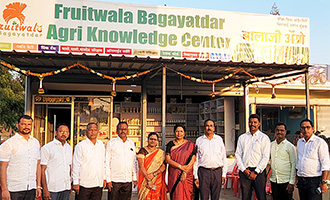
Soil Testing
Soil analysis plays a crucial role in agriculture as it provides valuable information about the nutrient content, pH level, organic matter content, and other important properties of the soil. This information helps farmers and agricultural professionals make informed decisions regarding fertilizers, crop selection, irrigation, and soil management practices. Here are some key aspects of soil analysis for agriculture:
Soil Sampling: Soil samples are collected from various points in the field using a soil sampling tool. Samples should be taken at a consistent depth and from representative areas to obtain an accurate analysis. Different areas within a field may have variations in soil properties, so it’s important to sample from multiple locations.
Nutrient Analysis: Soil analysis measures the levels of essential nutrients like nitrogen (N), phosphorus (P), potassium (K), calcium (Ca), magnesium (Mg), and micronutrients (such as iron, zinc, copper, and manganese). Nutrient deficiencies or excesses can impact plant growth and yield, so knowing the nutrient status of the soil helps determine appropriate fertilization strategies.
pH Analysis: Soil pH is a measure of its acidity or alkalinity. Different crops have different pH preferences, and soil pH affects nutrient availability. Most crops prefer a slightly acidic to neutral pH range (around 6 to 7), but this can vary. Adjusting pH through soil amendments, such as lime or sulfur, can help create an optimal growing environment for specific crops.
Organic Matter Analysis: Organic matter content in soil affects its fertility, water-holding capacity, and overall soil health. Organic matter provides nutrients, improves soil structure, and enhances microbial activity. Soil analysis helps determine the organic matter content, which can guide decisions on organic amendments and soil management practices.
Other Parameters: Soil analysis may also include assessments of physical properties like texture (proportions of sand, silt, and clay), cation exchange capacity (ability to hold and release nutrients), salinity, and moisture content. These parameters provide insights into soil structure, drainage, and potential challenges that need to be addressed.
Laboratory Analysis: Soil samples are typically sent to a reputable soil testing laboratory for analysis. The laboratory conducts tests using various techniques, including chemical extraction methods, spectroscopy, and other analytical procedures. The results are usually presented in a comprehensive soil report, which includes nutrient levels, pH, recommendations for amendments, and other relevant information.
By regularly conducting soil analysis, farmers can monitor changes in soil fertility over time and make necessary adjustments to optimize crop production. It’s important to consult with agricultural experts or local extension services to interpret the soil analysis results accurately and develop appropriate nutrient management plans for sustainable agriculture.
We provide Soil Testing service to farmers.
Water Testing –
Water analysis is crucial for farming as it provides valuable information about the quality and suitability of water for irrigation, livestock, and other agricultural purposes. Understanding the water composition helps farmers make informed decisions about irrigation practices, nutrient management, and potential risks to crops and livestock.
Regular water analysis is essential to ensure the quality and safety of irrigation water and protect crop health. The specific parameters tested and the acceptable ranges may vary depending on local regulations, crop requirements, and regional water quality conditions. It is advisable to consult with agricultural experts or local extension services for guidance on water analysis and to interpret the results accurately.
Petiole Testing –
Petiole analysis is a diagnostic tool used in crop nutrition management to assess the nutrient status of plants during their growth stages. Petioles are the leaf stems that connect the leaf blade to the plant stem. Analyzing the nutrient content of petiole tissues can provide valuable insights into the nutrient deficiencies or imbalances within plants. Here’s an overview of petiole analysis for crop nutrition management:
Sampling: Petiole sampling is typically done at specific growth stages of the crop, depending on the plant species and its nutritional requirements. The recommended growth stage for petiole sampling varies for different crops. Generally, it is done during active growth periods, such as flowering or fruiting stages.
Petiole Selection: When collecting petiole samples, it is important to choose healthy, mature leaves from the middle or upper part of the plant. Select leaves that are fully expanded but not yet senescent. Avoid leaves that are damaged, diseased, or affected by external factors that could skew the nutrient analysis.
Nutrient Analysis: The collected petiole samples are sent to a laboratory for nutrient analysis. The laboratory uses various techniques, such as spectroscopy or chemical extraction methods, to determine the nutrient concentrations within the petiole tissues. The analysis typically measures the levels of essential nutrients like nitrogen (N), phosphorus (P), potassium (K), calcium (Ca), magnesium (Mg), and other key micronutrients.
Nutrient Interpretation: The laboratory provides a nutrient analysis report indicating the concentrations of various nutrients in the petiole samples. These results are then compared to established nutrient sufficiency ranges or critical levels specific to the crop being grown. Nutrient sufficiency ranges are developed based on extensive research and help identify nutrient deficiencies or excesses in plants.
Nutrient Recommendations: Based on the petiole analysis results, nutrient recommendations can be formulated. If the nutrient concentrations in the petiole samples fall below the established sufficiency ranges, it indicates a nutrient deficiency. In such cases, appropriate fertilization strategies can be devised to address the deficiency and optimize crop nutrition. Conversely, if nutrient levels are above the sufficiency range, it may indicate excessive nutrient application or imbalances, requiring adjustments in fertilization practices.
Monitoring and Adjustments: Petiole analysis can be conducted periodically throughout the growing season to monitor nutrient status and make necessary adjustments to fertilizer programs. By tracking the nutrient levels in petiole tissues, growers can fine-tune their nutrient management plans to ensure that crops receive the optimal nutrient supply for healthy growth and maximum yield.
Petiole analysis provides a direct assessment of the nutrient status within the plant, enabling targeted and timely interventions to address nutrient deficiencies or imbalances. However, it’s important to note that petiole analysis should be used in conjunction with other diagnostic tools, such as soil analysis and visual crop inspections, to obtain a comprehensive understanding of crop nutrition and make well-informed management decisions. Consulting with agronomists or crop advisors is advisable for accurate interpretation of petiole analysis results and for tailored nutrient management recommendations.


